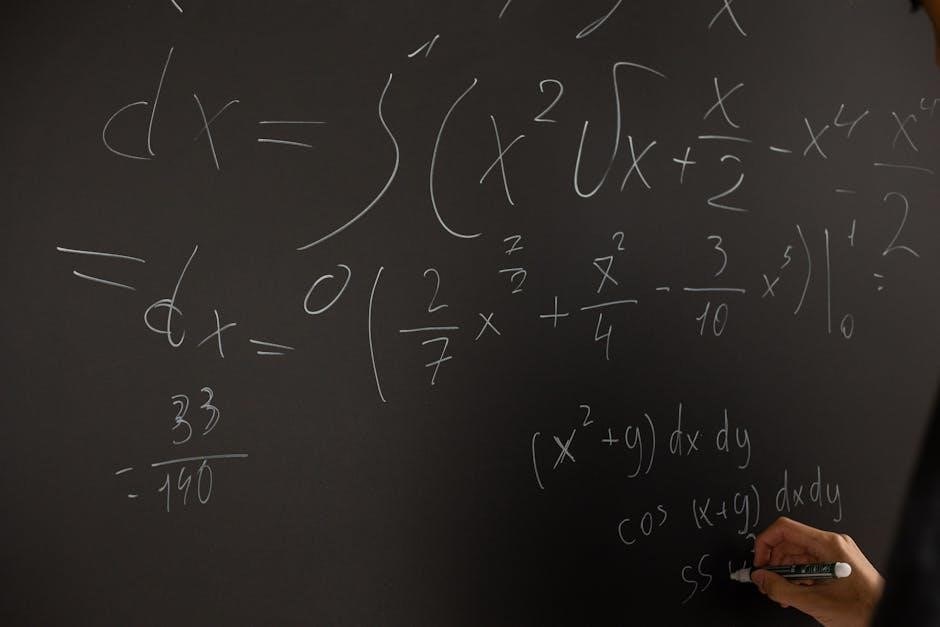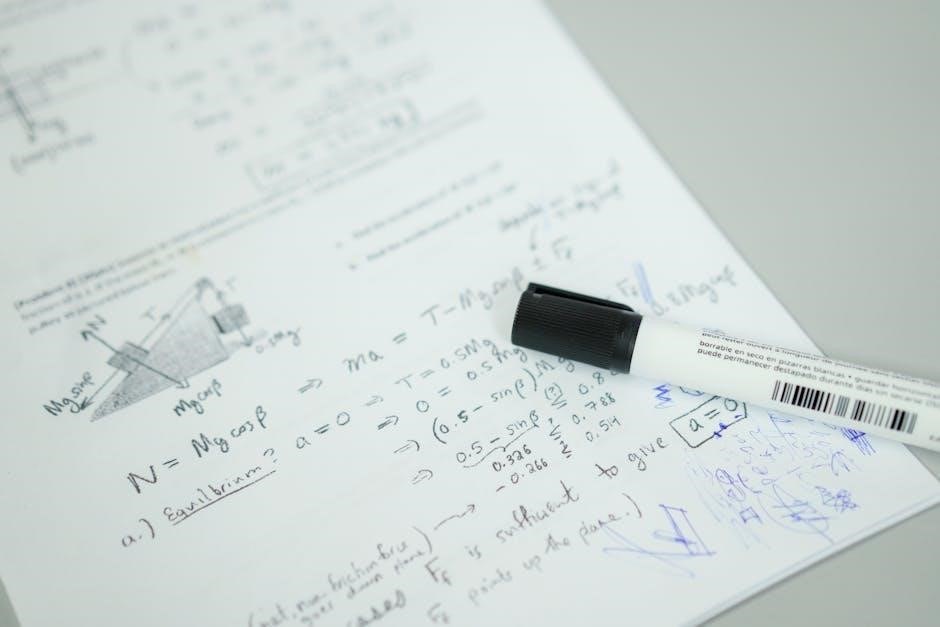
Mathematical physics bridges mathematics and physics‚ providing a rigorous framework for understanding natural phenomena. It combines advanced mathematical techniques with physical principles to describe and analyze complex systems.
By integrating calculus‚ differential equations‚ and abstract algebra‚ mathematical physics offers precise tools for modeling phenomena like quantum mechanics and general relativity‚ driving breakthroughs in modern science.
Definition and Scope
Mathematical physics is a interdisciplinary field that applies advanced mathematical methods to solve problems in physics. It seeks to formulate physical laws and phenomena using rigorous mathematical frameworks‚ ensuring precision and coherence in theoretical descriptions.
The scope of mathematical physics encompasses the development of mathematical tools tailored for physical systems‚ such as differential equations‚ vector calculus‚ and group theory. It bridges abstract mathematics with experimental physics‚ providing a foundational language for understanding complex systems in mechanics‚ electromagnetism‚ and quantum theory.

By integrating these elements‚ mathematical physics aims to derive accurate models of natural phenomena‚ fostering deeper insights into the underlying principles of the universe. Its applications span theoretical physics‚ engineering‚ and computational science‚ making it a cornerstone of modern scientific inquiry.
Historical Development
Mathematical physics traces its roots to ancient civilizations‚ where early mathematicians and philosophers sought to describe natural phenomena through numerical patterns and geometric relationships.
The formalization of mathematical physics began in the 17th century with Sir Isaac Newton‚ who unified celestial and terrestrial mechanics through his laws of motion and universal gravitation.
James Clerk Maxwell’s formulation of electromagnetic theory in the 19th century epitomized the power of mathematical physics‚ demonstrating how equations could predict physical phenomena with precision.
The 20th century saw revolutionary advancements‚ with Albert Einstein’s theory of relativity and the development of quantum mechanics by figures like Schrödinger and Heisenberg‚ deeply intertwining mathematics and physics.
Today‚ mathematical physics continues to evolve‚ driven by advances in computational methods and theoretical frameworks‚ addressing complex problems in cosmology‚ particle physics‚ and condensed matter physics.
Importance in Modern Science
Mathematical physics plays a pivotal role in modern science by providing the theoretical foundations for understanding complex phenomena and driving technological innovation.
It enables the development of precise models and simulations‚ crucial for fields like climate science‚ materials engineering‚ and medical imaging‚ where accurate predictions are essential.
By bridging abstract mathematical concepts with experimental physics‚ it fosters interdisciplinary research‚ leading to breakthroughs in quantum computing‚ relativity‚ and particle physics.
The rigorous analytical tools of mathematical physics also underpin advancements in data science and artificial intelligence‚ demonstrating its broad applicability across scientific domains.
Ultimately‚ mathematical physics serves as a cornerstone of modern scientific inquiry‚ connecting theory with practice and advancing our understanding of the universe.

Core Concepts in Mathematical Physics
Mathematical physics relies on fundamental concepts like vector calculus‚ differential equations‚ and group theory to model and analyze physical systems‚ forming the backbone of theoretical physics.
Vector Calculus and Linear Algebra
Vector calculus and linear algebra are foundational to mathematical physics‚ enabling the description of physical systems in multidimensional spaces. Key concepts include vectors‚ matrices‚ determinants‚ and operations like dot and cross products.
These tools are essential for analyzing electric and magnetic fields‚ fluid dynamics‚ and quantum mechanics. Linear algebra underpins quantum theory‚ while vector calculus describes spatial variations in physical quantities‚ forming the backbone of modern physics.
Understanding these areas allows physicists to model complex phenomena‚ solve systems of equations‚ and manipulate tensors‚ which are crucial in general relativity and particle physics.
Differential Equations and Their Applications
Differential equations are central to mathematical physics‚ describing how physical quantities change over space and time. They model dynamic systems‚ from simple harmonic motion to complex wave phenomena.
Ordinary differential equations (ODEs) and partial differential equations (PDEs) are key tools. ODEs govern systems with a single independent variable‚ while PDEs handle multiple variables‚ essential for field theories like electromagnetism and relativity.
Their applications span quantum mechanics‚ fluid dynamics‚ and thermodynamics. Solving these equations provides insights into natural laws‚ enabling predictions and deepening our understanding of the universe.

Group Theory and Symmetry Principles
Group theory is a fundamental area of mathematics that studies symmetry and structure in physical systems. It provides a framework for understanding transformations and invariances‚ crucial in quantum mechanics and relativity.
In quantum mechanics‚ symmetry principles are encoded in group representations‚ determining the behavior of particles and fields. Similarly‚ in general relativity‚ symmetry groups describe spacetime transformations‚ linking geometry to physical laws.
Group theory also underpins gauge symmetries‚ essential for modern particle physics and the Standard Model. These principles unify forces and predict particle interactions‚ demonstrating the profound interplay between mathematics and physical reality.

Mathematical Tools for Physics
Mathematical tools are essential for physics‚ enabling the formulation and solution of physical problems through advanced methods and theoretical frameworks‚ crucial in both theoretical and computational physics.
Calculus and Its Role in Physics
Calculus is a cornerstone of mathematical physics‚ providing essential tools for analyzing change and motion. It is divided into differential calculus‚ which studies rates of change and slopes‚ and integral calculus‚ which deals with accumulation and areas. These concepts are fundamental in physics for understanding phenomena such as velocity‚ acceleration‚ and energy. Calculus enables the formulation of laws like Newton’s laws of motion and the equations of electromagnetism. It also underpins quantum mechanics and relativity‚ where differential equations describe wave functions and spacetime curvature. Without calculus‚ modern physics would lack the mathematical framework to model and predict natural phenomena‚ making it indispensable for theoretical and applied physics alike.
Fourier Analysis and Transform Methods
Fourier analysis is a powerful tool in mathematical physics‚ enabling the decomposition of complex functions into sums of simpler sinusoidal components. This technique is crucial for solving partial differential equations‚ analyzing wave phenomena‚ and processing signals. The Fourier transform‚ in particular‚ converts functions between time and frequency domains‚ revealing hidden patterns and simplifying computations. In physics‚ it is applied to study wave propagation‚ quantum mechanics‚ and thermodynamics. Fourier methods also find applications in imaging and data analysis‚ making them indispensable in both theoretical and applied sciences. The ability to transform and analyze functions in different domains has revolutionized problem-solving in various fields‚ from acoustics to optics‚ solidifying Fourier analysis as a cornerstone of modern physics.
Functional Analysis and Hilbert Spaces

Functional analysis‚ a fundamental branch of mathematical physics‚ studies vector spaces equipped with advanced structures like norms and inner products. Hilbert spaces‚ in particular‚ are central to quantum mechanics‚ providing a framework for state spaces and operators. These spaces allow physicists to describe wave functions and observables rigorously. Key concepts include bounded linear operators‚ spectral theory‚ and orthogonality‚ which underpin quantum theories and differential equations. Hilbert spaces also facilitate the study of function spaces and integral equations‚ enabling solutions to complex physical problems. Their infinite-dimensional nature extends finite-dimensional linear algebra‚ offering a powerful toolkit for theoretical physics‚ ensuring precise formulations of quantum mechanics and beyond.

Applications of Mathematical Physics
Mathematical physics applies advanced mathematical techniques to solve physical problems‚ integrating theories like quantum mechanics and relativity. It models complex phenomena‚ driving innovations across modern science and engineering.

Quantum Mechanics and Quantum Field Theory
Quantum mechanics and quantum field theory form the cornerstone of modern theoretical physics‚ relying heavily on mathematical frameworks to describe atomic and subatomic phenomena. Key concepts include wave functions‚ operators‚ and Hilbert spaces‚ which provide a rigorous foundation for understanding quantum systems. The Schrödinger equation and Dirac formalism are central tools‚ enabling predictions about probabilities and system states. Quantum field theory extends these principles to relativistic contexts‚ introducing methods like path integrals and renormalization to study particle interactions and vacuum fluctuations. These theories are mathematically profound‚ employing advanced techniques from functional analysis and group theory to explore symmetry principles and gauge theories. Together‚ they represent a fusion of mathematical rigor and physical insight‚ driving our understanding of the quantum world.
General Relativity and Gravitational Physics
General relativity‚ formulated by Albert Einstein‚ revolutionized our understanding of gravity by describing it as the curvature of spacetime caused by mass and energy. The theory is rooted in mathematical frameworks like differential geometry and tensor calculus‚ with the Einstein Field Equations forming its core. These equations relate the curvature of spacetime to the stress-energy tensor of matter‚ providing a unified description of gravity across vast scales. Gravitational physics extends these principles to study phenomena such as black holes‚ gravitational waves‚ and cosmological expansion. Mathematical techniques like variational principles and symmetry analysis are essential for solving these complex equations‚ enabling predictions about spacetime dynamics and the behavior of massive objects.
Modern research in gravitational physics explores topics like quantum gravity‚ numerical relativity‚ and the intersection of general relativity with quantum mechanics‚ pushing the boundaries of theoretical and computational methods.
Statistical Mechanics and Thermodynamics
Statistical mechanics and thermodynamics form the foundation for understanding the behavior of systems at macroscopic and microscopic scales. Thermodynamics provides the framework for analyzing energy‚ entropy‚ and their transformations‚ governed by the four laws that dictate the principles of heat and work. Statistical mechanics extends this by connecting macroscopic properties to the statistical behavior of individual particles‚ using probability theory and ensemble methods. Mathematical tools like partition functions and the Boltzmann distribution are central to these analyses‚ enabling the calculation of system properties such as pressure‚ temperature‚ and entropy from molecular interactions. These fields are crucial for studying phase transitions‚ material properties‚ and biological systems‚ bridging the gap between quantum mechanics and macroscopic observations.
Modern applications include nonequilibrium thermodynamics and the study of complex systems‚ where advanced mathematical techniques are employed to model real-world phenomena.

Resources for Learning Mathematical Physics
Recommended textbooks include “Mathematical Methods of Physics” by Mathews and Walker. Online platforms like arXiv and ResearchGate offer free PDFs of research articles and lecture notes.
Recommended Textbooks and PDF Materials
For a strong foundation in mathematical physics‚ essential textbooks include “Mathematical Methods of Physics” by Mathews and Walker‚ known for its comprehensive coverage of key mathematical tools. Additionally‚ “The Feynman Lectures on Physics” provides an insightful blend of physics and mathematics; Online resources like arXiv and ResearchGate offer free PDFs of research articles and lecture notes‚ ideal for advanced topics. Platforms such as SpringerLink and ScienceDirect also provide accessible PDF materials. A notable resource is the 532-page compilation of “This Week’s Finds in Mathematical Physics”‚ covering quantum mechanics and theoretical physics. These materials cater to both beginners and advanced learners‚ ensuring a well-rounded understanding of the field.
Online Courses and Tutorials
Online resources provide accessible learning opportunities for mathematical physics. Platforms like Coursera and edX offer courses from prestigious universities‚ covering topics from vector calculus to quantum mechanics. The PhET Interactive Simulations project offers free‚ interactive tools for visualizing complex physics concepts. YouTube channels such as 3Blue1Brown and Physics Girl present engaging explanations of mathematical physics principles; Additionally‚ forums like Physics Stack Exchange and Math Overflow allow learners to ask questions and engage with experts. Websites like Khan Academy provide supplementary materials for self-study‚ ensuring a comprehensive understanding of mathematical physics. These resources cater to both beginners and advanced learners‚ offering flexible and interactive learning experiences.
Research Articles and Journals
Research articles and journals are essential for exploring the latest advancements in mathematical physics. Publications such as Journal of Mathematical Physics and Communications in Mathematical Physics offer peer-reviewed articles on topics like quantum mechanics‚ relativity‚ and statistical mechanics. These journals provide in-depth analyses and cutting-edge research‚ often available in PDF formats for easy access. Platforms like arXiv and ScienceDirect host a wide range of mathematical physics papers‚ enabling researchers to stay updated on theoretical developments. Additionally‚ open-access repositories ensure that high-quality research is accessible to students and professionals alike‚ fostering collaboration and innovation in the field.

Modern Advances in Mathematical Physics
Modern advances in mathematical physics include string theory‚ topological quantum field theories‚ and computational methods‚ revolutionizing our understanding of fundamental physics and its mathematical foundations.
String Theory and Its Mathematical Foundations
String theory proposes that fundamental particles are vibrating strings‚ unifying quantum mechanics and general relativity. It requires higher-dimensional spacetime and uses mathematical tools like Calabi-Yau manifolds and D-branes. The theory relies on supersymmetry and conformal field theory‚ offering insights into quantum gravity and the early universe. Despite being highly speculative‚ string theory has deeply influenced modern theoretical physics‚ inspiring new mathematical frameworks. Its intricate mathematical foundations continue to drive research‚ bridging physics and advanced geometry. Researchers explore string theory’s potential to explain phenomena beyond the Standard Model‚ making it a central area of study in mathematical physics.
Topological Quantum Field Theories
Topological Quantum Field Theories (TQFTs) represent a captivating intersection of topology and quantum field theory‚ offering novel insights into physical systems by emphasizing their topological properties. Rooted in the principles of quantum mechanics and the mathematical framework of topology‚ TQFTs explore how physical systems maintain certain invariants under continuous deformations. These theories are particularly significant in condensed matter physics‚ where they describe topological phases‚ such as insulators and superconductors‚ and in theoretical physics‚ where they are applied to string theory and black hole physics.
TQFTs utilize advanced mathematical tools like category theory and knot theory‚ providing a highly abstract and general framework applicable across various spacetime dimensions. The historical development of TQFTs‚ influenced by scholars such as Michael Atiyah and Edward Witten‚ underscores their importance in modern physics. To fully comprehend TQFTs‚ one must explore both their mathematical underpinnings and their physical applications‚ making them a thrilling area where mathematics and physics converge to elucidate quantum systems and spacetime.
Computational Methods in Theoretical Physics
Computational methods in theoretical physics leverage numerical simulations and algorithms to solve complex physical problems. These tools are essential for modeling systems that are difficult to analyze analytically‚ such as fluid dynamics‚ quantum many-body systems‚ and relativistic phenomena. Techniques like Monte Carlo simulations‚ finite element methods‚ and lattice gauge theory are widely employed. Programming languages such as Python‚ MATLAB‚ and C++ are integral to these computations‚ enabling the development of custom software for specific physical scenarios. Additionally‚ high-performance computing (HPC) clusters are utilized to handle large-scale simulations‚ particularly in cosmology and particle physics. Computational methods also facilitate the integration of machine learning‚ enhancing predictive capabilities and data analysis. These approaches bridge theory and experiment‚ driving advancements in our understanding of the universe.